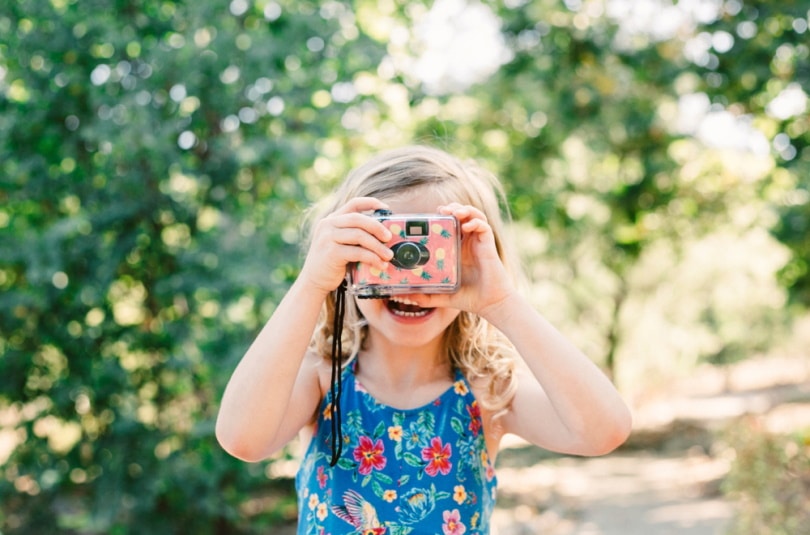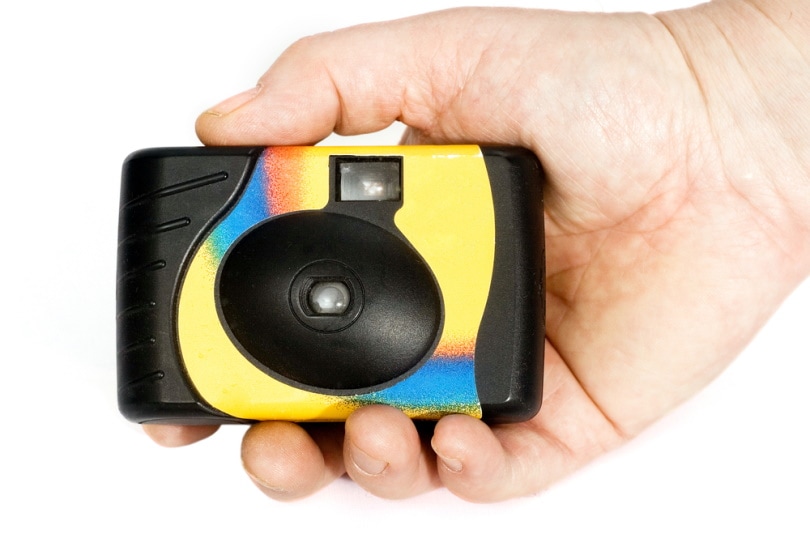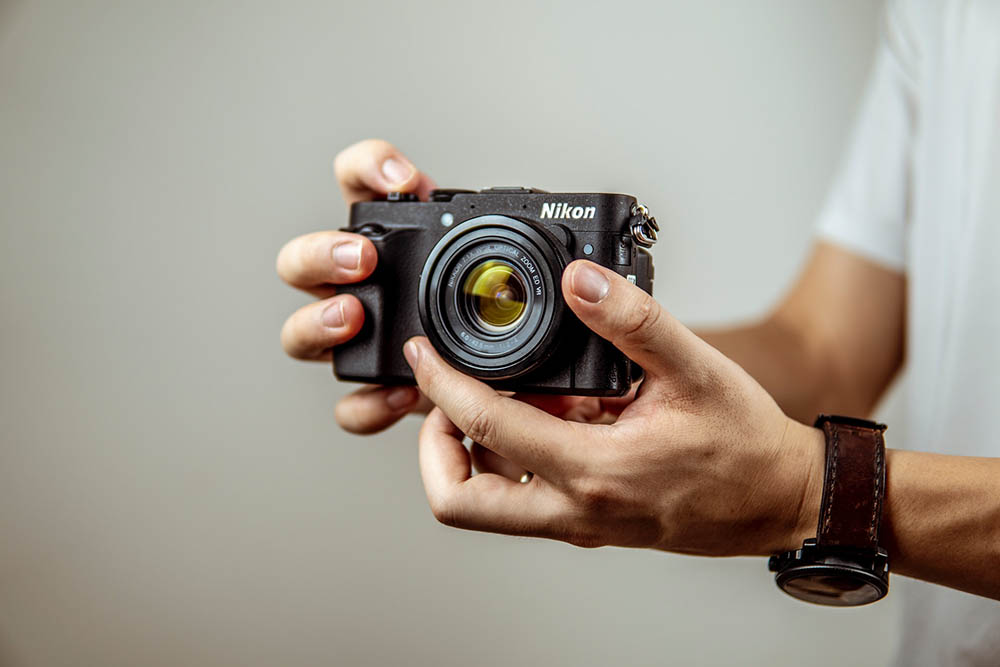How Do Disposable Cameras Work? Types, Pros & Cons
Last Updated on

Perhaps you remember using one when you were younger, way before the days of smartphones. Disposable cameras are a novelty with a purpose. They allow you to take pictures on the go without investing in equipment. It wouldn’t break the bank if you lost it, although you may have thought some of your pics were priceless.
While you may associate them with the 1980s or 1990s, disposable cameras that use film go back to 1888 with the Ready Fotografer. Inventor Alexander Pope Whittell wanted to make photography affordable. Bear in mind that back in the day, cameras cost about $50, or today’s equivalent of $1,400. Even though Whittell’s invention was short-lived, it opened up a new world to enthusiasts.
Fast forward to 1987 to find a solid product niche filled by Kodak and Fujifilm. Both companies still make disposable cameras today, albeit with a modern twist.

How Does It Work?
Disposable cameras work essentially the same as reusable ones. The difference lies with the structure. Early models used cardboard, making them the essence of a one-time-use product. Later, they were made from plastic, which added to their durability and versatility.
Disposable cameras have a shutter that opens to focus light on a medium. Film cameras typically have preloaded 35 mm film, although ones with 110 mm were also available. They are usually barebones without the bells and whistles of reusable cameras. You won’t be able to take fancy shots or change the settings. They also have a limited number of exposures.

What Are the Different Types of Disposable Cameras?
You’ll find disposable film cameras in a broad spectrum of price points, with many products under $50. Keep in mind that it is just the cost of the device and not the process of developing the film. You’ll see disposable cameras with or without a flash. There are products that fulfill everyday use. However, there are also models with wide-angle lenses and products suitable for specific conditions.
Some manufacturers, such as Ilford, produce cameras with preloaded monochrome film to add an artistic element to your shots. If color is more your thing, then LomoChrome has you covered with a model that adds a purple tint to your images. Some manufacturers push the envelope of disposable cameras with multiple uses.
One of the most useful additions to the market has been the introduction of waterproof cameras. These cameras are an excellent option for those who don’t want to invest in expensive reusable ones. It’s essential to check the specs on these products for depth and time of exposure. Some manufacturers may label their products with an ingress protection (IP) rating to help you compare cameras.
A recent innovation was the 2004 introduction of the disposable digital model by Pure Digital Technologies. In our fast-paced society, having to wait to get the film developed is a barrier to the disposable film camera’s success. Moving to the digital front allowed these products to gain a foothold in these markets. Users could now preview images and delete them as desired. However, it didn’t replace a visit to the shop to develop them.

When to Use Them
The selling point for disposable cameras is their portability. You can keep one with you to take pictures on the go. As we discussed, you can buy ones for specific uses, such as being outdoors, wide-angle cameras for landscapes, or underwater photography. Most products are compact and much smaller than a DSLR camera.
While you’re not going to be taking Ansel Adams’ shots, you can capture some decent ones. The charm is in the imperfections of the photographs. It’s ironic that the more powerful smartphones have camera apps that replicate these effects for their nostalgic value.
Advantages of Disposable Cameras
The primary advantage of disposable cameras is their low cost. Their lower prices make them a viable option for taking photographs in challenging conditions. You can take one with you on a mountain hike without the fear of losing or breaking your smartphone. It’s undoubtedly preferable to be out $20 for a disposable camera than the hundreds or even thousands of dollars for a new phone.
The different types of disposable cameras can open up new opportunities for photography with the wide-angle lenses and waterproof models we’ve mentioned. Even though many products are made of plastic, you’ll find many that are recyclable, making them eco-friendly purchases.

Disadvantages of Disposable Cameras
The main disadvantage of disposable cameras is the picture quality. Unfortunately, some of the settings where you might opt to use one are the very situations you would want to have high-quality photos. The other glaring con is film development. It’s an added cost that makes it a hassle to use these products. You’ll also have to wait to see your pictures. Impatient users will find it a dealbreaker.
Suffice to say that using a film camera isn’t the same thing as pointing your smartphone at a subject. Think about those apps that can correct imperfections or allow you to doctor up your images. Pictures from a disposable camera have a raw quality about them that may not suit all uses.

Frequently Asked Questions (FAQs)
How do you use a disposable camera?
Depending on the disposable camera, you may need to insert a battery or the film. Then, it’s simply a matter of turning the wheel until it stops. You’ll have to turn on the flash manually for some cameras. Instead of using your smartphone’s screen, you’ll use the viewfinder to aim the camera. We suggest taking your time and looking at the scene from different angles before shooting. Remember, you have a limited number of shots.

Can you create any special effects with a disposable camera?
You can do some cool things with these cameras. However, some methods may trash the camera for subsequent shots. There’s also a learning curve with some of them. You may have even created some special effects unintentionally before. You can get a double exposure by hitting the underside of the device after taking a pic. Then, wind the thumb wheel only halfway. The result is an overlay shot.
How much does developing the film cost?
It depends on the type of disposable camera. If it’s a film camera, you can expect to pay anywhere from $0.50 to $4.00 a print, depending on the size and finish. It can also take up to 10 days to get them back. Disposable digital cameras are a different story, with lower costs and quicker turnaround times.

Conclusion
Disposable cameras still have a place in today’s high-tech world. They can extend your photography possibilities to different scenarios that your smartphone can’t manage. If you’re curious about learning about photography, these products offer an inexpensive way to try your hand at it. Advances in technology have improved the quality of the images you’ll capture. It’s a fun way to dabble in this hobby without a huge investment.
Featured Image Credit: Shannon West, Shutterstock
About the Author Chris Dinesen Rogers
Chris has been writing since 2009 on a variety of topics. Her motto with all of her writing is “science-based writing nurtured by education and critical thinking.” Chris specializes in science topics and has a special love for health and environmental topics, and animals of all shapes and sizes.
Related Articles:
How to Clean a Refractor Telescope: Step-by-Step Guide
How to Clean a Telescope Eyepiece: Step-by-Step Guide
How to Clean a Rifle Scope: 8 Expert Tips
Monocular vs Telescope: Differences Explained (With Pictures)
What Is a Monocular Used For? 8 Common Functions
How to Clean a Telescope Mirror: 8 Expert Tips
Brightfield vs Phase Contrast Microscopy: The Differences Explained
SkyCamHD Drone Review: Pros, Cons, FAQ, & Verdict
